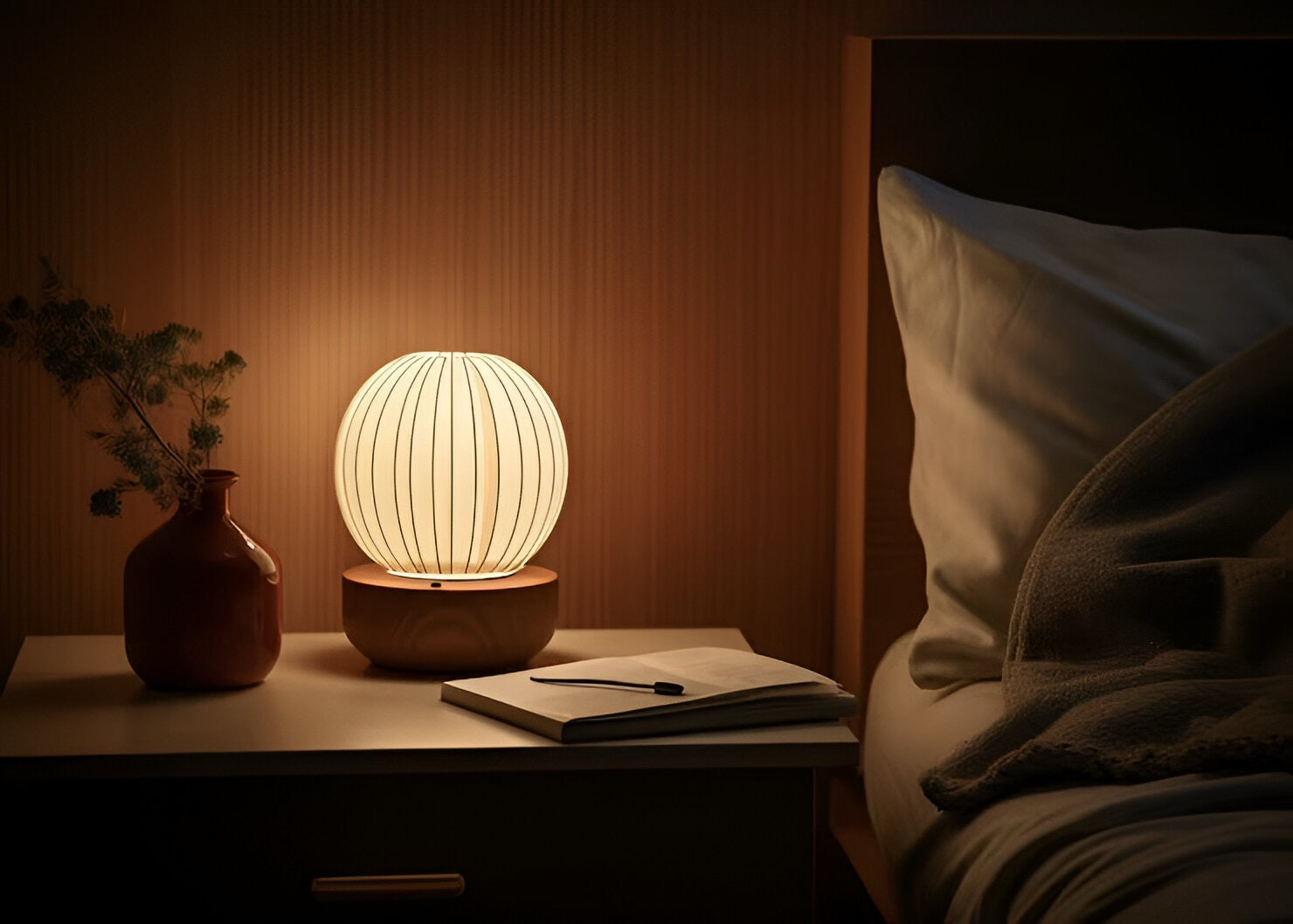
Night Light for Adults: The Complete Guide to Better Sleep to Avoid Blue Light
Choosing the right night light: What really matters when it comes to light color, brightness and control
It's three o'clock in the morning. You wake up, have to go out for a moment and grope through the darkness, blinking. First instinct? Light on. And at that moment it happens: a bright, cold beam of light from the hallway or bathroom hits your eyes like a blow. You are immediately wide awake. It's almost impossible to think about falling asleep again quickly. Does this sound familiar?
We often think of night lights as being for children who are afraid of the dark. But the truth is: As adults, we may need them even more – but for a completely different reason. It's not about fear of monsters, but about protection from an invisible enemy of our sleep: blue light. The ironic result is that most "solutions" to darkness, from bright bathroom lights to glowing cell phone screens, sabotage our sleep more than the darkness itself. This guide explains why this is the case and how the right night light can not only help you get through the night more safely, but actively improve your sleep.
Your complete roadmap to better sleep through better light:
- The Invisible Troublemaker: What Blue Light Really Does to Your Body
- The solution is not darkness, but the right light
- The Checklist: What to Look for in a Night Light for Adults
- The right placement: where the night light belongs (and where it doesn't)
- More than just night lights: How to optimize your entire evening routine
- Conclusion: Take back control of your night
The Invisible Troublemaker: What Blue Light Really Does to Your Body
To understand the problem, we need to take a quick look at our internal clock, the so-called circadian rhythm. This 24-hour cycle controls countless processes in our body, especially the sleep-wake rhythm. The most important clock for this clock is light.
Our brains have been programmed to do this for thousands of years: bright, bluish light (like that of the midday sky) means "day, be awake, get active!". Darkness and warm, reddish light (like a sunset or campfire) mean "night, to rest, to sleep."
When our eyes encounter blue light, they send a strong signal to our brain to immediately stop producing the sleep hormone melatonin. Melatonin is the hormone that makes us tired and sleepy. Without it we cannot fall asleep or stay asleep well. And this is exactly where the problem with modern light sources lies: Most standard LEDs, energy-saving lamps and especially the screens of our cell phones, tablets and televisions emit an enormously high proportion of blue light.
So when you get up at night and turn on the regular hallway light or, even worse, take a quick look at your phone, you're essentially telling your brain, "Watch out, it's midday! Wake up!" Melatonin production collapses and your body switches from sleep to wake mode. The train has left.
The solution is not darkness, but the right light
Although complete darkness is ideal for sleep, it is often impractical in everyday life and unsafe for many. Who wants to trip over the cat or miss the door frame? The solution is an orientation light that is bright enough to help you find your way safely, but whose light spectrum does not interfere with melatonin production. A night light without any significant blue light content.
This “sleep-friendly” light doesn’t send a “wake up!” signal to the brain. It allows you to orient yourself while your body remains in sleep mode. The transition back to bed and into deep sleep is so effortless.
The Checklist: What to Look for in a Night Light for Adults
A good night light is much more than just a weak lamp. It is a precise instrument. Here are the three crucial criteria you need to pay attention to.
Criterion #1: The light color – the decisive factor
This is the most important point. Forget the cold, white or even blue night lights from the hardware store. They look for light in the long wavelength spectrum.
- Warm white to extra warm white (below 2700 Kelvin): This is the absolute minimum requirement. This light has a lower blue content and is reminiscent of the light from an old light bulb. It's a good compromise between orientation and sleep-friendliness.
- Amber colored (Amber, approx. 1600-2200 Kelvin): This is the better choice. This orange-yellow light has almost no blue component and is ideal for bedrooms and hallways. It imitates the light of candlelight or a fireplace.
- Red light: This is the gold standard for sleep purists. Red light has the longest wavelength and has been shown to disrupt melatonin production the least. It may look hard to get used to at first, but scientifically it is the best color for a night light.
Criterion #2: Brightness – Why less is more
The goal is orientation, not illumination. A good night light should be just bright enough for you to see the outline of furniture and doors. Brightness is measured in lumens (lm). Values between 1 and 10 lumens are usually completely sufficient for a night light. Anything brighter can be too stimulating, even if the light color is right.
A dimmable night light is ideal because you can adjust the brightness perfectly to your needs and the size of the room. What is just right in the long hallway can be too bright in the small bedroom. With a dimmer you have full control.
Criterion #3: The control – intelligent and needs-based
A night light that stays on all night is usually unnecessary. Intelligent controls not only save electricity, but also ensure that the light is only on when you need it.
- Twilight sensor: a must. This sensor ensures that the night light is automatically activated at dusk and switched off again at daybreak.
- Motion detector: The best combination. The light only comes on when movement is detected in the room and switches off again after a short time (e.g. 30-60 seconds). This is perfect for hallways, stairs and the bathroom. You don't have to look for a switch and the light only disturbs you for a minimal period of time.
The right placement: where the night light belongs (and where it doesn't)
Positioning is also crucial to minimize the disruptive effect.
- Rule #1: As deep as possible. Ideally, mount the night light in one Power plug near the ground. The light falls on the ground and illuminates the path without shining directly into your eyes.
- In the bedroom: Place it so that it is not directly visible from the bed, for example behind the bed frame or a dresser. It's just meant to create a soft glow that illuminates the floor.
- In the hallway and on the stairs: Here several weak lights are better than a single bright one. They create a safe "light path".
- In the bathroom: A dedicated red night light with a motion detector is worth its weight in gold here. It prevents the shock from the bright main light and leaves you half asleep.
More than just night lights: How to optimize your entire evening routine
A sleep-friendly night light is an important component, but for maximum success, consider it as part of a larger strategy to reduce blue light in the evening.
- The “Digital Sunset”: Set a fixed time (e.g. 9 p.m.) from which all screens are off limits. No cell phone, no tablet, no TV in bed.
- Use night mode: Enable “Night Shift” or night mode on all your devices. This reduces the blue content and gives the screen a warmer color.
- Blue light filter glasses: If you can't do without screens in the evening, special glasses with orange or red lenses can effectively block blue light.
- Dim your main lighting: Replace your regular overhead lights with dimmable, warm white bulbs and dim the lights significantly in the last hour or two before bed.
Conclusion: Take back control of your night
A good night light for adults is not a gimmick. It is a powerful tool for improving your sleep hygiene. It is the conscious decision to give your body the right signals at the right time. By banishing the invisible sleep predator - blue light - from your nighttime environment, you create the ideal conditions for quickly and effortlessly getting back to restful sleep after a short interruption.
Investing in one or two thoughtful amber or red motion sensor night lights is one of the easiest and most effective changes you can make for your health and well-being. It's about taking back control and making the night what it should be: a time of undisturbed rest and regeneration.

About the author: Robin Aebischer
As founder of BUYnBLUE and Lumoir Jewelry I share my passion for unique designs and current trends. My goal is to inspire you and help you find the right designer pieces that underline your personality and give you joy for a long time.


